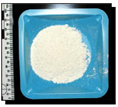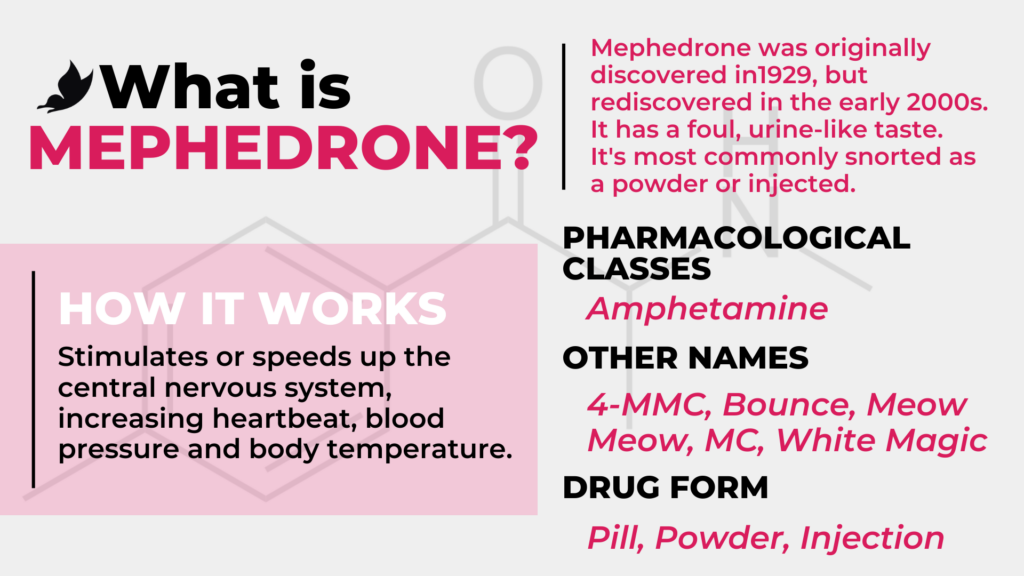Mephedrone is a synthetic stimulant that speeds up the central nervous system. It can also increase your heartbeat, blood pressure and temperature. More scientifically, it’s a substituted cathinone that also falls in the amphetamine class of drugs. Like substances found in the khat plant, a commonly used plant found in Africa, mephedrone produces effects similar to amphetamine, cocaine, and ecstasy (MDMA). The drug was actually legal for a relatively long time and used by more adventurous clubgoers in Europe. Common street names for the drug include “meow meow,” “M-CAT,” “drone,” “plant food,” and “white magic.”

People take mephedrone to experience a rush of intense pleasure, including an intense connection with music. Common side effects include paranoia, hallucinations, panic attacks and delirium. The drug can also cause blurred vision, memory loss, muscle tension, anxiety, dry mouth, stomach pain and intense sweating which could lead to dehydration.

Who Made Mephedrone?
Mephedrone was originally discovered in 1929 under a different, more technical chemical name, but was rediscovered in 2003 by a clandestine chemist participating in a forum on drug chemistry called “The Hive” from Israel. The Israeli chemist went under the name of “Kinetic” and claimed mephedrone was as good as ecstasy. Once his manufacturing method spread, the drug grew in popularity. By the mid-2000s, it was being seized by authorities on the European continent that thought they were seizing ecstasy pills.
What Mephedrone Does to the Body
Users of the drug claim it provides them with a more mild and tolerable form of the cocaine high. Many people say mephedrone produces a high similar to ecstasy. It’s commonly snorted as a powder, or swallowed as a pill, but can also be injected, which is the most dangerous way of taking the drug. Mephedrone has a difficult time crossing the blood-brain barrier, so higher doses are usually required to reach a desired high. It can easily cause an overdose. Because of that the drug is not recommended for anyone. Lawmakers have classified mephedrone as a scheduled B substance in the United States. Possession of the drug could get you up to five years behind bars.
What are Cathinones?
Cathinones, often called bath salts when synthetically produced, are becoming increasingly popular on the black market as a way of using “research chemicals” without trying something completely unknown. Their effects don’t deviate too much from what users recognize as halfway between an entheogen (like MDMA, a substituted phenethylamine) and stimulant. Much of the internet stock that was sold in the drug’s heyday was very pure compared to other drugs purchased off the internet; there’s a theory supported by UK government data that the rise of mephedrone was spurred on by rapidly decreasing MDMA purity.
Mephedrone is an interesting case of when drugs are popularized mostly through a concerted campaign by a national government to clamp down on the use of something they deem dangerous. Most use of the drug didn’t occur en masse until it was discussed on the news or in the papers as something risky and dangerous that causes outlandish behavior by those who consumed even a small amount of the substance. While the drug will, in fact, cause such outlandish behavior in large doses, it’s used by a large swath of European clubgoers for the most part, representing a high rate of illegal use of the wildly-varying cathinone drug depending on the clandestine manufacturing process.
Pharmacology of Mephedrone
Mephedrone, also known as 4-methylmethcathinone (4-MMC), is a synthetic psychoactive substance with stimulant properties. It belongs to the cathinone family of compounds, which are naturally found in the khat plant (Catha edulis). The chemical structure of mephedrone closely resembles other cathinones, amphetamines, and phenethylamines.
Mechanism of Action
Mephedrone acts as a monoamine releasing agent, primarily affecting three neurotransmitters in the brain: dopamine, serotonin, and norepinephrine. It stimulates the release of these neurotransmitters while inhibiting their reuptake, leading to increased levels of these chemicals in the brain.
The increase in dopamine levels is responsible for the stimulant effects and feelings of euphoria experienced by users, while the surge in serotonin levels can cause increased sociability, mood enhancement, and emotional bonding. The increase in norepinephrine levels is responsible for the drug’s stimulant effects on the cardiovascular system, such as elevated heart rate and blood pressure.
Pharmacokinetics
Mephedrone can be consumed through various routes, including oral ingestion, insufflation (snorting), intravenous injection, and rectal administration. The drug’s onset, duration, and intensity of effects may vary depending on the route of administration.
After administration, mephedrone is rapidly absorbed into the bloodstream, with peak plasma concentrations reached within one to two hours for oral ingestion and much faster for insufflation or injection. The drug’s half-life ranges from two to four hours, which means that its effects can last for several hours, depending on the dose and individual metabolism.
Metabolism and Excretion
Mephedrone is primarily metabolized in the liver by various enzymes, including CYP2D6, which converts it into active metabolites. These metabolites are further broken down and eventually excreted through the kidneys in the urine. Some of the drug is also eliminated unchanged in the urine.
Potential for Dependence and Addiction
Mephedrone has a high potential for abuse and addiction due to its stimulant effects and the rapid onset of pleasurable sensations it induces. The drug’s mechanism of action on dopamine and serotonin levels in the brain can lead to compulsive use and addiction. Repeated use of mephedrone can result in the development of tolerance, requiring users to consume higher doses to achieve the desired effects. Additionally, withdrawal symptoms such as fatigue, depression, and anxiety may occur upon cessation of use, further contributing to the drug’s addictive potential.
It is important to note that mephedrone’s pharmacological properties, mechanism of action, and potential for addiction are not yet fully understood, as research on the substance is limited. However, the available evidence suggests that mephedrone poses significant risks to users’ physical and mental health.
Learn more
To learn more about how Landmark Recovery treats substance use disorders, give us a call at 888-448-0302 today to speak with a dedicated admissions specialist. They can help you learn about our treatment options and figure out what path you should take to gain successful treatment for a substance use disorder. Unlock your potential when you discover the power of recovery today.

Choose Recovery Over Addiction
We're here 24/7 to help you get the care you need to live life on your terms, without drugs or alcohol. Talk to our recovery specialists today and learn about our integrated treatment programs.




